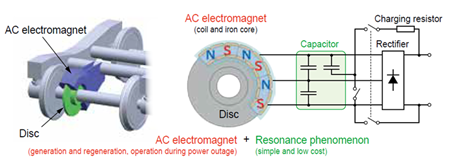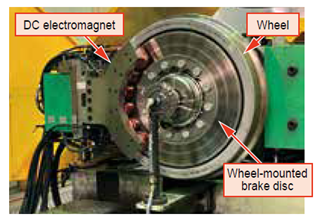29. Non-contact Disc Brake Enabling Power Regeneration in Trailers
In recent years, there has been growing demand for decarbonization of train operations and development of energy-efficient vehicles, along with the need to reduce consumables and automate maintenance. Replacing the axle mounted discs on trailers with electric brakes can reduce energy consumption and consumables. However, this requires installing motors, inverters, gear units, and other equipment on the trailers, which presents challenges such as high installation costs.
We proposed a non-contact disc brake (Figure 1) with a simple circuit configuration that does not use inverters or similar equipment, enabling a simplified electric brake system for trailers. In this electric brake, braking force and regenerative electric power are generated by flowing electric current through resonance phenomenon between an electromagnet and a capacitor.
To confirm feasibility, a proof-of-concept test was conducted, verifying that braking and power regeneration are possible through resonant current flow (Figure 2). Additionally, to obtain fundamental data needed for future full-scale design, element tests using a full-size DC electromagnet were conducted (Figure 3), clarifying the relationship between disc temperature, which reaches several hundred °C, and braking torque. Furthermore, we devised a method to determine the capacitor capacitance needed to achieve the desired resonance state, addressing the complex changes in electrical characteristics that occur according to the brake operating conditions. Based on these tests and study results, we proposed a fundamental design method.
Building on these results, we will advance performance evaluations at the full-scale level and develop detailed design methods tailored to operating conditions, aiming to realize a non-contact disc brake that contributes to energy-saving and low-maintenance railway vehicles.
Other Contents
- 27. Method for Estimating the Density of Newly Fallen Snow Using Dual-polarization Radar
- 28. Prediction Method for Long-term Deformation Behavior of Concrete Bridges Considering Water Content Conditions
- 29. Non-contact Disc Brake Enabling Power Regeneration in Trailers
- 30. Method for Reducing Unstable Vibrations of Pantographs Caused by Sliding Friction
- 27. Method for Estimating the Density of Newly Fallen Snow Using Dual-polarization Radar
- 28. Prediction Method for Long-term Deformation Behavior of Concrete Bridges Considering Water Content Conditions
- 29. Non-contact Disc Brake Enabling Power Regeneration in Trailers
- 30. Method for Reducing Unstable Vibrations of Pantographs Caused by Sliding Friction



